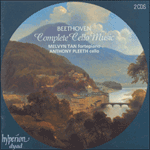The first movement of the D major Sonata shows evidence of the new possibilities available in the cello writing with a singing, dolce first subject. Despite the Adagio being the first real slow movement of these Sonatas, the main melody is a rather restrained affair, with short rests at the end of each two-bar phrase – the smoother melodic writing is reserved for the middle section of the ABA structure. The finale follows without a break, though not before tentative attempts at the main subject forestall the arrival of the movement proper – a fully-fledged fugue. In fact this is the first occasion where Beethoven uses a fugue as the basis of a movement (instead of merely incorporating fugal writing into another form), and is thus also the first example of the contrapuntal thinking that was to dominate his final years.
from notes by Matthew Rye © 1996
Le premier mouvement de la sonate en ré majeur illustre les nouvelles possibilités de l’écriture violoncellistique, avec un premier thème chantant, dolce. Bien que l’Adagio soit le véritable premier mouvement de ces sonates, la mélodie principale est plutôt contenue, avec de courtes pauses à la fin de chaque phrase de deux mesures – une écriture mélodique plus fluide étant réservée à la section centrale de la structure ABA. Le finale suit immédiatement, sans qu’une seule tentative préliminaire du thème principal vienne anticiper l’arrivée du mouvement en tant que tel – une fugue à part entière. Pour la première fois, Beethoven prend pour base du mouvement une fugue (au lieu de simplement incorporer une écriture fuguée dans une autre forme). Pour la première fois aussi, il nous offre un exemple de la pensée contrapuntique qui allait dominer ses dernières années.
extrait des notes rédigées par Matthew Rye © 1996
Français: Hypérion
Der erste Satz der Sonate in D-Dur deutet jene neuen Möglichkeiten an, die die Komposition für Cello durch ein singendes erstes dolce Thema bereicherten. Obwohl in diesen Sonaten das Adagio praktisch den ersten richtigen langsamen Satz darstellt, verbleibt die Hauptmelodie noch verhalten, mit kurzen Pausen am Ende jeder zweitaktigen Phrase – die glattere und sanftere melodische Komposition wird dem mittleren Abschnitt der ABA-Struktur vorbehalten. Das Finale setzt unmittelbar ein, jedoch nicht, bevor zögernde Versuche des Hauptthemas der Ankündigung des eigentlichen Satzes zuvorkommen – mit einer ausgewachsenen Fuge. Tatsächlich bedient sich Beethoven hier erstmals einer Fuge als Satzbasis (anstatt andere fugenähnliche Kompositionstechniken anzuwenden), und das Werk ist somit das erste, das von jenen kontrapunktischen Überlegungen geprägt ist, die schließlich die Werke seiner letzten Jahre dominieren sollten.
aus dem Begleittext von Matthew Rye © 1996
Deutsch: Ute Mansfeldt


 Beethoven: Cello Sonatas
Beethoven: Cello Sonatas Beethoven: Complete Cello Music
Beethoven: Complete Cello Music
